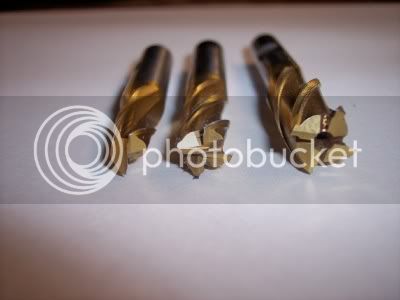Oh man, complex topic!
Some thoughts:
- The more flutes, the more its like running your spindle faster. For the same spindle speed, a 4 flute can be fed twice as fast as a 2 flute, and a 3 flute can be fed 50% faster. Think of it as a "spindle speed multiplier". Many mills in home shops are rpm challenged, particularly on materials like aluminum that want a lot of rpm, hence you can gain some advantage with more flutes.
This is not true cutter geometry from a 2 and 3 flute to a 4 flute changes considerably and the 4 flute does not have the correct margin clearance for softer material. It may sound logical but it isn't you will actually be able to feed faster with a 2 flute in aluminum due to the clearance.
- If you stick more flutes down the hole, it means less room for the chips though. Some materials, like aluminum, have some "sticky" chips that like to cause trouble. Hence we prefer fewer flutes in aluminum when we are worried about clearing out the chips. 2 or 3 flutes work best.
- Get the chips out! Recutting is hard on tools and ruins the surface finish. You probably don't want the mess of flood coolant, but at least try a strong air blast. It's easy to arrange a nozzle on your spindle to keep the chips out of your way. Your tools will thank you as will your work.
This is true the reason the chips are hard on tools they are harder than the material being cut.
- If you must slot full width, and this is never the most accurate way to slot (you should full width down the middle leaving room for a finish pass that only cuts one side of the slot or other), a 2 flute is more accurate because of the way the flutes pull against the sides of the hole. I have not noticed much difference on this phenomenon personally, BTW.
Cutter flex is always there you may notnotice it if you cut your feed down.
- You can use 4 flutes, 5 flutes, or however many flutes on aluminum just fine provided there is adequate chip clearance. I always get a better finish peripheral milling around the outside of a part with a 4 flute. It's that faster spindle speed phenomenon again. And, because it isn't down in a hole, but cutting around the outside, there is plenty of room for the chips to get out of the way, so the cutter is not bothered. This is a trick I learned from Widgitmaster over on CNCZone.
Again I humbly disagree you can get a better finish with faster feed in aluminum with a 3 or a 2 flute em.It all has to do with the cutter geometry. Believe me I've been doing this for 35 years and there are a lot of misconceptions when it comes to feed and tool selection.
Speeds and feeds matter more than you'd think for finish and tool life. There are lots of rules of thumb, but is surprising how far many of them will put you from the manufacturer's recommended speeds and feeds. One of the biggest advantages of CNC is you can reproduce exactly the feedrates called for on a job over and over again. You can dial it in to perfection.
I wrote a feed and speed calculator after I got tired of figuring it all out by hand every cut to get it right. It's called G-Wizard and you're all welcome to try it.
Cheers,
BW








